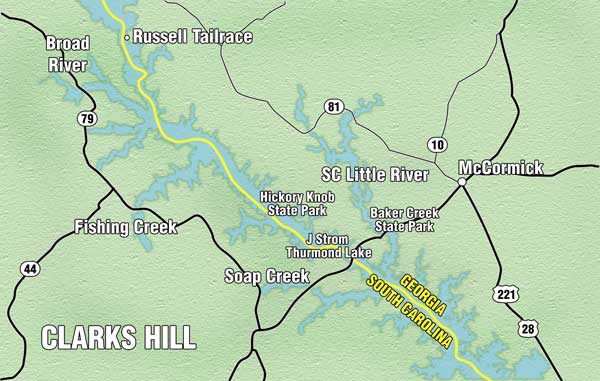
Long-line trolling will produce great crappie catches on Thurmond this month.
Lake Strom Thurmond, better known by the politically incorrect as Clarks Hill Lake, was built between 1946 and 1954 by the U.S. Army Corps of Engineers near the confluence of the Little River and the Savannah River.
At more than 70,000 acres, “The Hill” is the second-largest artificial lake east of the Mississippi River. Clarks Hill Dam is just upstream from Augusta, Ga., and along its reach back to Lake Russell, the lake is the recreational focal point of several small communities along the South Carolina/Georgia border.
Unlike some of South Carolina’s other crappie hotspots, Clarks Hill is a considerable distance from a major population center and receives much less fishing pressure. Factor in that the lake is surrounded by some of the land in the state for deer hunting, and it’s pretty common to have major stretches of the lake all to yourself in October.
So fall fishing at Clarks Hill is one of the best kept secrets in the crappie world — with only a few insiders knowing what the lake has to offer after the summer crowds are gone and the deer hunters are in the woods.
Two of the “insiders” are Dereck Fulton, a part-time guide, and Jon Cannon, a regular on the South Carolina Crappie Association trail. Both look forward to the fall, when they can load the livewell by long-lining for slab crappie.
For Fulton, a BnM pro-staffer, the beautiful surroundings, the solitude and the joy of being back home are enough to get him on the water. A communications officer in the U.S. Army based at nearby Fort Gordon, he has been active duty for nearly 20 years, including a tour in Desert Storm and two tours in Operation Iraqi Freedom. Back from his second tour in Iraq last fall, Fulton, who is well known for his long-lining prowess, resumed guiding.
Cannon, a native of Chapin, fishes with his father, Ellis Cannon, the SCCA president, and they have consistently finished high in tournaments all over the state — with most of their success due to their long-lining tactics.
Long-lining is a popular, multiple-rod trolling tactic that can produce good numbers of crappie throughout the year. It is distinguished from “spider-rigging” by the positioning of rods and the amount of line in the water. In crappie circles, spider-rigging — or tight-lining — is often referred to a “pushing,” while long-lining is called “pulling.”
“You still have rod holders all over the boat, so it’s hard to tell which tactic somebody is using until you see where the rods are and where the anglers are sitting,” Fulton said. “In my set-up, I run eight rods across the back and three up each side. I’ll use a BnM Buck’s graphite jig pole — the long, dark-blue poles — on the sides of the boat, with a 14-footer toward the bow, a 12-footer in the middle, and a 10-footer toward the stern. All eight of the rods across the transom are 5½-foot BnM graphite spinning rods.”
Jon Cannon sets up similarly, but he limits the number of rods to 12, which conforms to his club’s rules.
“We cast each rod out about 40 feet,” Cannon said. “All of our rods are rigged with single, 1/16th-ounce jigs. The depth the jig is fished is controlled by the speed of the boat when trolling. We start out trolling up around 1.3 miles per hour if the fish are shallow or suspended shallow in two to three feet of water, and we slow down to around a half-mile per hour if the fish are deep, like 15 to 20 feet. If they are that deep, we may add a single split shot to the line about two feet above the jig to help get it down.”
Both Fulton and Cannon rely heavily on a variable-speed trolling motor to do most of the work when it comes to maintaining proper speed and course during a long-line run.
“I use the MinnKota Terrova, which has the auto-pilot function,” Fulton said. “This lets me set a course, and the trolling motor will make adjustments by itself from an internal compass.”
“I like the variable speed control on my Minn Kota Power Drive,” Cannon said. “Because we control depth by our speed, I have to be able to make slight adjustments to compensate for any wind current or waves while we’re fishing.”
Rod-holder setups are as varied as the individuals who fish with them. Many will use commercially-made rod-holders from companies like Driftmaster, Tite-Lok, or Perotti-Built, while others design and build their own. What’s most important is to have the rod-holders positioned so that they allow a spread of the lines coming from numerous rods of varying lengths to cover the most water without getting lines tangled.
Long-lining is primarily used with artificial baits. The idea is to present some variation of a crappie jig to mimic a disoriented baitfish swimming through the water. Although both anglers may tip their jigs with live baits when the water temperatures cool later in the year — or if fishing gets slow — straight jigs are usually the call.
“ My favorite jighead is made by a company in Gainesville, Ga., called Micro Spoons,” Fulton said. “They use a sickle hook to make their 1/16th-ounce jigs, and I combine these with a Southern Pro Hot Grub. The sickle hook is lower profile, and I don’t think it hangs up as much; they’re also extremely sharp. I’ll combine that with the Hot Grub in a John Deere green, black-and-chartreuse or a light purple jig they call ‘Wildcat.’ Those are my best fall colors at Clarks Hill.”
Cannon has his own ideas about jigs.
“We use a number of different jigs, but we probably like Kalin’s the best,” said Cannon. “The curlytail is real thin, and that makes for better action, especially at slower speeds. Anything with orange in it has been a good color for us.”
Clarks Hill is big enough to intimidate some fishermen. Fulton and Cannon eliminate lots of water by choosing to concentrate on the major tributary arms, removing the main Savannah River channel, the tailrace below Lake Russell, and the main-lake basin in front of the dam from the realm of possibilities.
“We’ve done well in different areas all over the lake,” Cannon said. “For this time of year, I think all the major creeks will hold fish if there are baitfish present.”
Cannon suggests going about three-quarters of the way back into major tributaries like Soap Creek, Fishing Creek, or Little River on either side of the lake. They want to find baitfish working toward the backs of the creeks out over the creek channel.
“The water temperatures will be somewhere in the 70s, and that pushes baitfish back in the creeks,” Fulton said. “Crappie will also move in behind them, but they’ll be relating to the edge of the creek channel as they move. I always make sure I’m over the top of some type of channel break when I’m long-lining — except during the spawn when the crappie are up on a flat.”
Fulton’s ideal depth will be somewhere between 12 and 22 feet. He’ll find crappie suspending in the water column, wherever the bait is holding, over these depths.
Cannon’s target depths during October run from 18 to 24 feet. He said crappie may be suspended anywhere over those depths depending on where the baitfish are.
‘We want to pull our jigs right through the baitfish, but two to three feet above the level of the crappie. If we pull below them, they just won’t bite.” Cannon said.


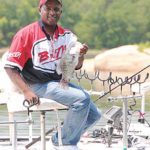
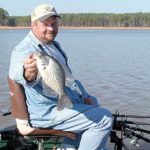
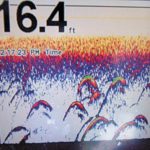
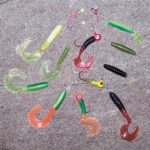
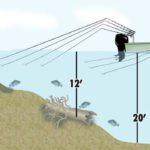
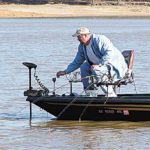



Be the first to comment